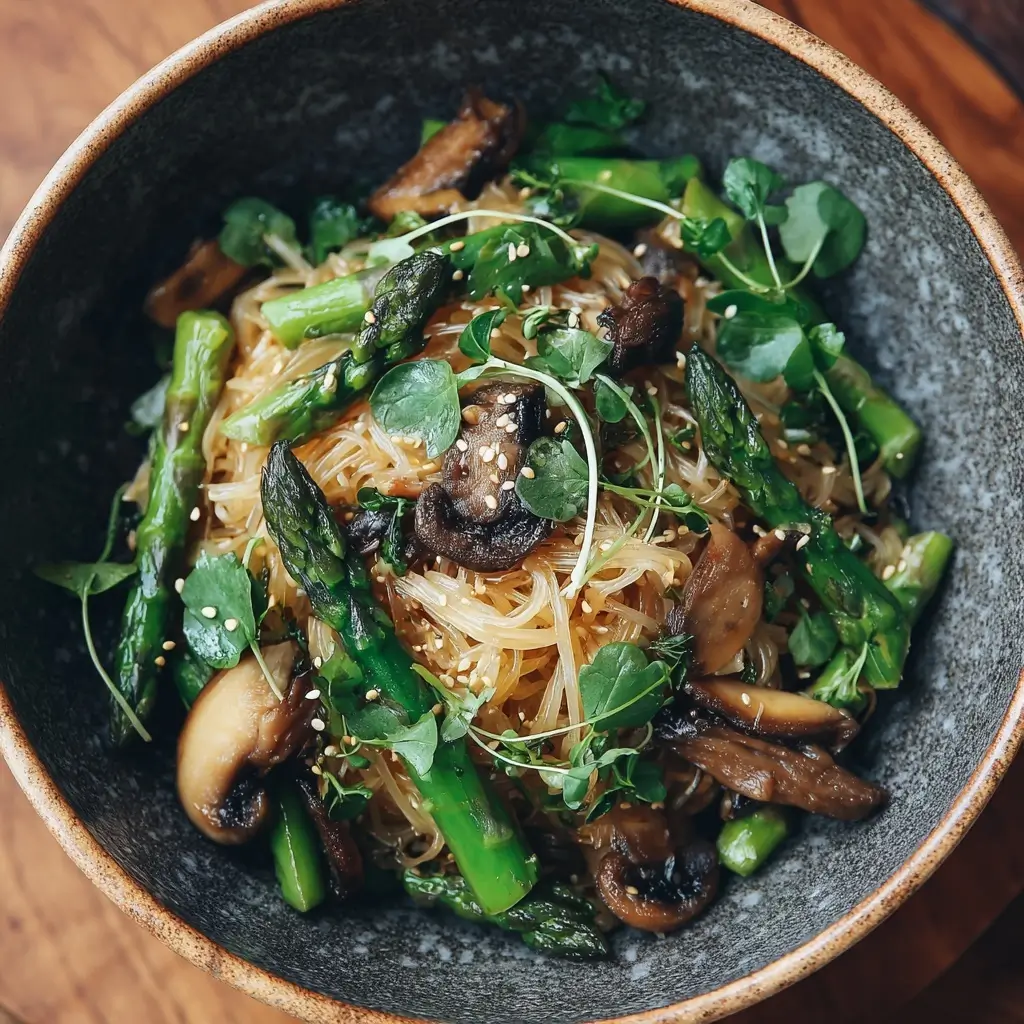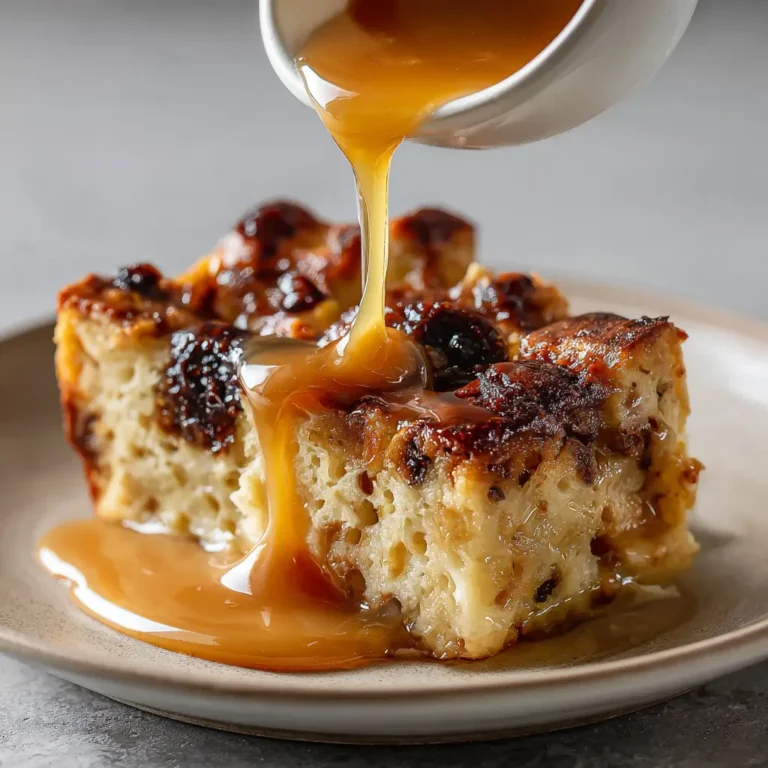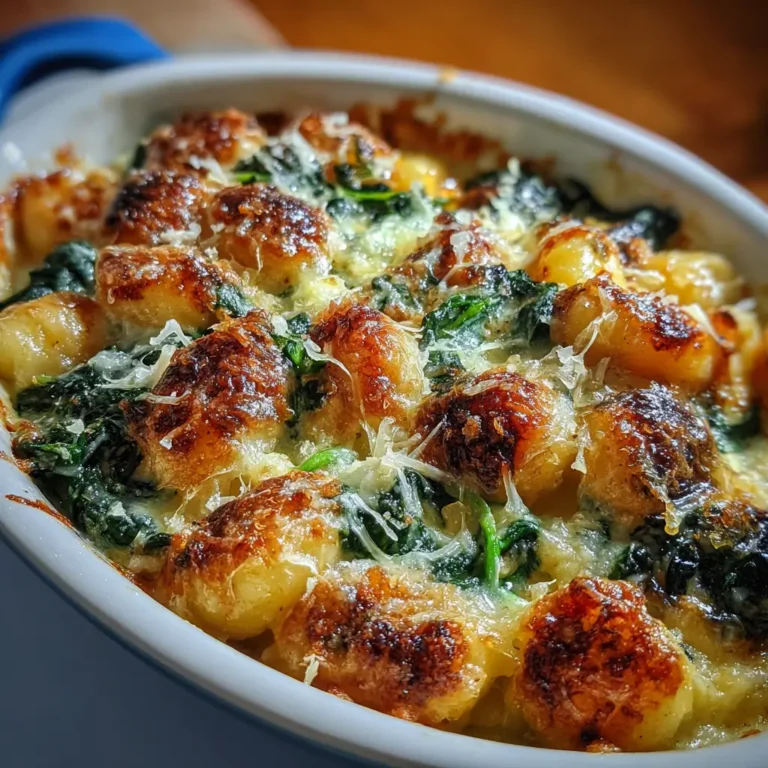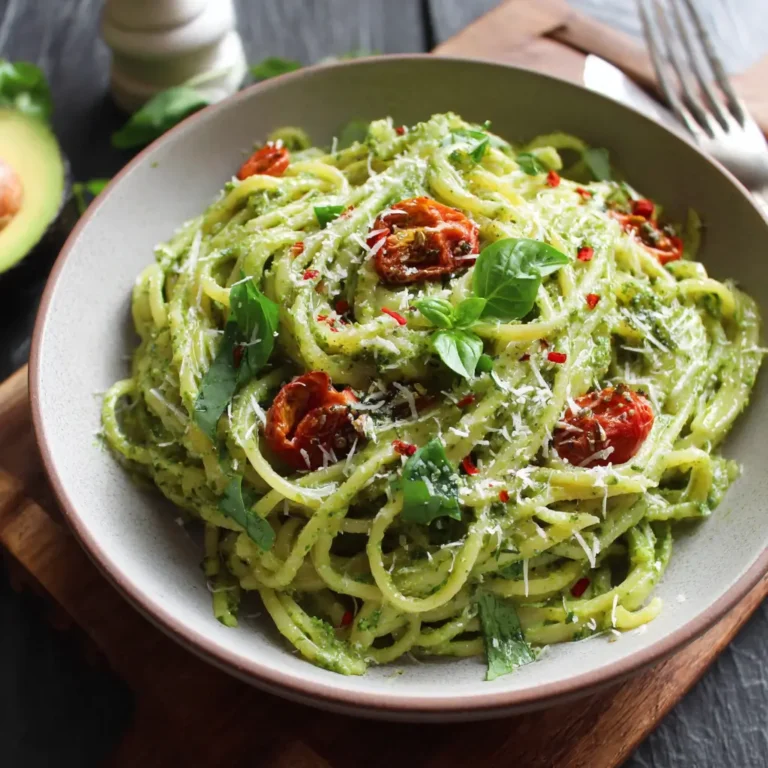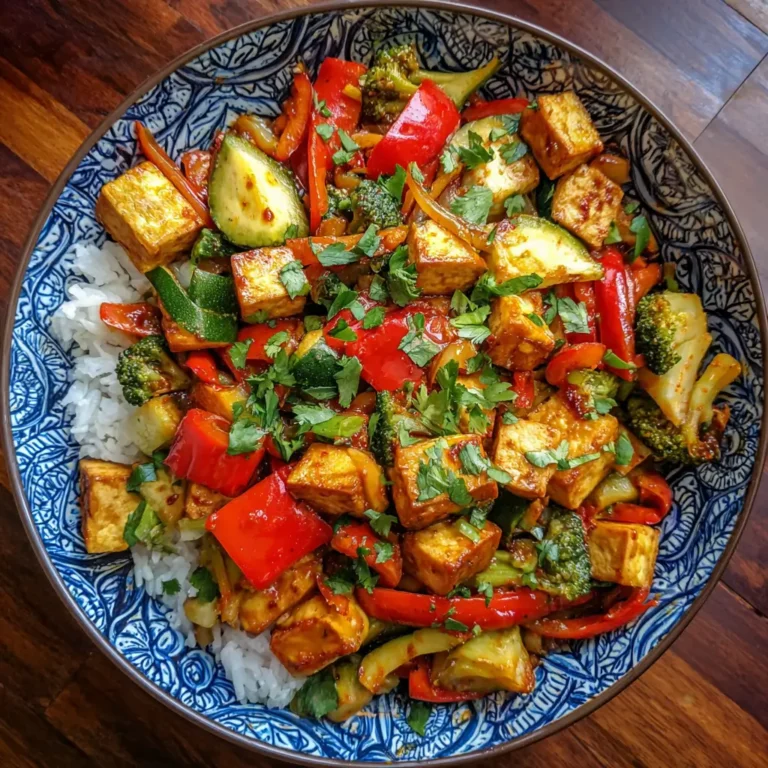Hot Sesame Rice Noodles with Asparagus, Shiitakes and Pea Shoots
Hot Sesame Rice Noodles with Asparagus, Shiitakes and Pea Shoots
Indulge in a vibrant, aromatic bowl of Hot Sesame Rice Noodles with Asparagus, Shiitakes, and Pea Shoots—a dish that marries the earthy depth of mushrooms, the crisp freshness of asparagus and pea shoots, and the luxurious silkiness of rice noodles bathed in a rich sesame-infused sauce. This recipe brings together bold Asian flavors with wholesome ingredients, making it an ideal choice for a quick weeknight dinner or an elegant plant-based meal to impress guests. Whether you’re following a vegan lifestyle or simply looking to incorporate more vegetables into your diet, this dish delivers on taste, texture, and nutrition.
The History
Rice noodles have been a staple in Asian cuisine for centuries, with roots tracing back to southern China, Vietnam, Thailand, and Malaysia. Their light, gluten-free nature made them popular across regions where rice cultivation was abundant. Over time, rice noodle dishes evolved with regional variations—some stir-fried, others served in broths, and many tossed in flavorful sauces.
Sesame oil and seeds, meanwhile, have long been valued in Chinese and Japanese culinary traditions not only for their nutty flavor but also for their medicinal properties in traditional medicine. The use of shiitake mushrooms dates back over 1,000 years in East Asia, prized for both their umami richness and immune-boosting benefits. Asparagus, though originally from the Mediterranean, has become a common spring vegetable in Asian cooking, especially when paired with delicate greens like pea shoots—tender young leaves of the pea plant known for their sweet, grassy flavor.
This particular fusion dish reflects modern interpretations of classic Asian flavors, blending traditional elements with contemporary health-conscious cooking. It draws inspiration from Cantonese stir-fries, Japanese soba preparations, and Korean sesame-heavy dressings, resulting in a globally influenced yet deeply satisfying meal.
Ingredients Breakdown
Every ingredient in this dish plays a crucial role in building layers of flavor, texture, and nourishment:
- Rice Noodles: Gluten-free and delicate, these provide a neutral base that absorbs the bold sesame sauce beautifully. Look for flat rice noodles (like those used in pad Thai) for optimal sauce adherence.
- Asparagus: Adds a crisp-tender bite and bright green color. Rich in fiber, folate, and vitamins A, C, and K, asparagus brings both nutrition and elegance.
- Shiitake Mushrooms: These meaty fungi contribute deep umami and a satisfying chew. When sautéed, they release a savory essence that enhances the entire dish.
- Pea Shoots: Tender, slightly sweet, and packed with antioxidants, pea shoots add a fresh, garden-like quality. They’re often used in Chinese stir-fries and salads for their vibrant flavor and visual appeal.
- Toasted Sesame Oil: The star of the sauce, this oil offers a rich, nutty aroma that defines the dish. Use pure toasted sesame oil (not raw) for maximum flavor impact.
- Soy Sauce or Tamari: Provides saltiness and depth. Tamari is recommended for a gluten-free option with a smoother, less harsh profile.
- Rice Vinegar: Adds brightness and balances the richness of the sesame oil.
- Maple Syrup or Agave: A touch of sweetness rounds out the sauce and complements the sesame notes.
- Fresh Garlic and Ginger: Essential aromatics that build the flavor foundation, adding warmth and pungency.
- Red Pepper Flakes or Fresh Chili: For heat lovers, this adds a spicy kick that contrasts beautifully with the creamy sesame.
- Sesame Seeds (white and black): Used as a garnish, they add crunch and visual contrast while boosting the nutty theme.
- Green Onions and Cilantro: Fresh herbs that bring a pop of color and herbal brightness at the end.
- Vegetable Broth (optional): Used to deglaze the pan or loosen the sauce if needed, ensuring every strand of noodle is coated evenly.
Step-by-Step Recipe
- Soak the Rice Noodles: Place rice noodles in a large bowl and cover with hot (not boiling) water. Let sit for 8–10 minutes, or according to package instructions, until tender but still slightly firm. Drain and rinse under cold water to stop cooking. Toss with a teaspoon of neutral oil (like grapeseed or avocado) to prevent sticking. Set aside.
- Prepare the Sauce: In a small bowl, whisk together 3 tablespoons toasted sesame oil, 3 tablespoons soy sauce or tamari, 1 tablespoon rice vinegar, 1 tablespoon maple syrup, 2 minced garlic cloves, 1 tablespoon grated fresh ginger, and ½ teaspoon red pepper flakes (adjust to taste). Taste and adjust—add more sweetness, acidity, or salt as desired. Set aside.
- Sauté the Shiitakes: Heat 1 tablespoon neutral oil in a large wok or skillet over medium-high heat. Add sliced shiitake mushrooms (stems removed, caps thinly sliced), and sauté for 5–7 minutes until golden brown and tender. Sprinkle with a splash of soy sauce during cooking to enhance umami. Remove and set aside.
- Cook the Asparagus: In the same pan, add a bit more oil if needed. Toss in trimmed and cut asparagus (into 2-inch pieces), and stir-fry for 3–4 minutes until bright green and crisp-tender. You can cover briefly to steam if you prefer softer asparagus. Remove and combine with mushrooms.
- Combine Everything: Return the cooked rice noodles to the pan over medium heat. Pour the prepared sesame sauce over the noodles and toss gently to coat evenly, using tongs or two forks. Add the sautéed shiitakes and asparagus, and toss again to integrate.
- Add the Pea Shoots: Turn off the heat. Gently fold in a generous handful of fresh pea shoots. The residual heat will slightly wilt them without losing their freshness and color.
- Final Touches: Taste and adjust seasoning—add a squeeze of lime juice for brightness or extra chili for heat. Transfer to serving bowls.
- Garnish and Serve: Top with sliced green onions, chopped cilantro, a sprinkle of toasted white and black sesame seeds, and optional extra chili flakes or crushed peanuts for crunch.
Tips
- Don’t Overcook Noodles: Rice noodles go from perfect to mushy quickly. Always test early and rinse with cold water after soaking to control texture.
- Bloom the Aromatics: For deeper flavor, briefly sauté the garlic and ginger in sesame oil before mixing into the sauce—but be careful not to burn them.
- Prep Ahead: Chop all ingredients before starting. Stir-frying happens fast, so having everything ready ensures even cooking.
- Use Fresh Ginger and Garlic: Avoid pre-minced versions for superior taste and zing.
- Balance the Sauce: Aim for harmony between salty, sweet, sour, and spicy. Taste as you go!
- Keep Pea Shoots Raw (Almost): Adding them off-heat preserves their delicate texture and nutritional value.
- Wok Hei (Breath of the Wok): If using a well-seasoned carbon steel wok, crank the heat high for a smoky, restaurant-style finish.
Variations and Customizations
This recipe is highly adaptable—perfect for cleaning out the fridge or tailoring to dietary preferences:
- Protein Boost: Add pan-seared tofu, tempeh, seitan, or shredded poached chicken. Marinate proteins in a bit of the sauce beforehand for extra flavor.
- Vegetable Swaps: Substitute asparagus with broccoli, sugar snap peas, bok choy, or baby corn. Shiitakes can be replaced with oyster or cremini mushrooms.
- Noodle Alternatives: Try soba noodles (for a nutty buckwheat flavor) or udon (for chewiness), though note these are not gluten-free.
- Spice Level: Increase heat with sriracha, sambal oelek, or a drizzle of chili oil. For mild versions, omit peppers entirely.
- Sauce Variations: Add a spoonful of tahini for creaminess, or a dash of hoisin for complexity. A splash of miso paste deepens umami.
- Raw Version (No-Cook Option): Skip sautéing and serve as a chilled sesame noodle salad—perfect for summer.
- Low-Sodium Option: Use low-sodium tamari and reduce added salt. Boost flavor with lemon zest or mushroom powder.
Health Considerations and Nutritional Value
This dish is naturally plant-forward, nutrient-dense, and easily modifiable for various diets. Here’s a breakdown of its health benefits:
- Gluten-Free: When using rice noodles and tamari, this meal is safe for those with celiac disease or gluten sensitivity.
- Vegan and Plant-Based: Entirely free of animal products, making it ideal for plant-powered eaters.
- Rich in Antioxidants: Sesame oil contains sesamol and vitamin E; asparagus and pea shoots are loaded with antioxidants like glutathione and vitamin C.
- Supports Heart Health: Monounsaturated fats in sesame oil may help lower LDL cholesterol when used in place of saturated fats.
- Digestive Benefits: Fiber from vegetables and rice noodles supports gut health and regularity.
- Immune Support: Shiitakes contain beta-glucans, compounds shown to enhance immune function.
- Low in Saturated Fat: Especially when prepared with minimal oil, this dish is heart-healthy.
- Source of B Vitamins: Brown rice noodles (if used) and mushrooms contribute B3 (niacin) and B5 (pantothenic acid).
Nutritional Estimate (per serving, serves 4):
Calories: ~380 | Carbohydrates: 55g | Protein: 9g | Fat: 16g (mostly unsaturated) | Fiber: 6g | Sugar: 8g (natural from maple syrup & veggies) | Sodium: ~800mg (varies by soy sauce)
Ingredients
- 8 oz (225g) dried flat rice noodles
- 1 bunch asparagus, trimmed and cut into 2-inch pieces
- 1 cup shiitake mushrooms, stems removed, thinly sliced
- 2 cups fresh pea shoots
- 3 tbsp toasted sesame oil (plus 1 tsp for garnish if desired)
- 3 tbsp soy sauce or tamari (low-sodium if preferred)
- 1 tbsp rice vinegar
- 1 tbsp pure maple syrup or agave nectar
- 2 cloves garlic, minced
- 1 tbsp fresh ginger, grated
- ½ tsp red pepper flakes (or to taste)
- 1 tbsp neutral oil (grapeseed, avocado, or sunflower)
- 2 green onions, thinly sliced
- ¼ cup fresh cilantro, chopped
- 1 tbsp toasted sesame seeds (white, black, or mix)
- Optional: lime wedges, crushed peanuts, chili oil
Directions
- Soak rice noodles in hot water for 8–10 minutes until al dente. Drain, rinse with cold water, toss with a little oil, and set aside.
- In a bowl, whisk together sesame oil, soy sauce, rice vinegar, maple syrup, garlic, ginger, and red pepper flakes. Set sauce aside.
- Heat neutral oil in a wok or large skillet over medium-high. Sauté shiitakes for 5–7 minutes until browned and tender. Remove and set aside.
- Add asparagus to the same pan; stir-fry 3–4 minutes until crisp-tender. Remove and combine with mushrooms.
- Return noodles to the pan. Pour sauce over and toss to coat evenly over medium heat.
- Add mushrooms and asparagus back in; toss to combine.
- Turn off heat. Fold in pea shoots gently until just wilted.
- Taste and adjust seasoning. Add a splash of lime juice or more chili if desired.
- Divide into bowls. Garnish with green onions, cilantro, sesame seeds, and optional extras.
- Serve immediately, preferably while steaming hot and fragrant.
FAQ
Can I make this ahead of time?
Yes, but best assembled just before eating. Prep components separately: cook noodles, make sauce, chop veggies. Store in airtight containers for up to 2 days. Reheat noodles and veggies, then toss with sauce and fresh pea shoots.
Are rice noodles healthy?
They are gluten-free and low in fat, but primarily a source of carbohydrates. Opt for brown rice noodles for added fiber and nutrients.
Can I freeze leftovers?
Not recommended. Rice noodles tend to become mushy upon thawing. Enjoy within 1–2 days refrigerated.
What can I use instead of pea shoots?
Baby spinach, arugula, or microgreens work as substitutes. For similar texture, try watercress or tender bok choy leaves.
Is toasted sesame oil the same as regular sesame oil?
No. Toasted sesame oil is darker, richer, and used for flavor (usually added at the end). Regular (raw) sesame oil is lighter and better for high-heat cooking.
How do I store shiitake mushrooms?
Keep them in a paper bag in the refrigerator crisper drawer. Avoid plastic, which traps moisture and speeds spoilage.
Can I make this oil-free?
Yes—use water or vegetable broth to sauté instead of oil. The sesame flavor will still come through in the sauce, though texture may be less glossy.
Summary
A fragrant, satisfying bowl of Hot Sesame Rice Noodles with Asparagus, Shiitakes, and Pea Shoots brings together bold flavors and vibrant textures in a wholesome, plant-based meal. Quick to prepare and endlessly customizable, it’s a celebration of spring produce and Asian-inspired comfort food.
